Impact of Bark-Sourced Building Blocks as Substitutes for Fossil-Derived Polyols on the Structural, Thermal, and Mechanical Properties of Polyurethane Networks
Abstract
:1. Introduction
2. Materials and Methods
2.1. Materials
2.2. Preparation of Bark-Sourced Polyol
2.3. Composition of Bark-Sourced Polyol
2.3.1. UPLC-ELSD Chromatography
2.3.2. Total Polyphenolic Content
2.3.3. Proanthocyanidins Content
2.3.4. Monomeric Sugar Content
2.4. Functionality of Bark-Sourced Polyol
2.4.1. Wet Chemistry Analysis
2.4.2. 31P NMR
2.4.3. Gel Permeation Chromatography
2.5. Synthesis of PU Networks
2.6. Characterization of PU Networks
2.6.1. FTIR Spectra
2.6.2. Glass Transition Temperature (Tg) by Differential Scanning Calorimetry (DSC)
2.6.3. Non-Isothermal TG/DTG/DSC of PU Network in Air
2.6.4. Tensile Tests of PU Networks
2.6.5. The Sol Fraction Content in Cured PU Networks
3. Results
3.1. Composition and Functionality of Black Alder Bark-Sourced Bio-Polyol
3.2. Formulation and Structural Characteristics of Polyurethane Networks Depending on the Content of Bark-Sourced Bio-Polyol
3.2.1. Crosslink Density of Polyurethane Networks versus Composition
3.2.2. FTIR Spectra of PU Networks
3.3. Thermal Properties of PU Networks Depending on the Content of Bark-Sourced Bio-Polyol
3.3.1. Glass Transition Temperature
3.3.2. Thermal Degradation of PU Networks in Air
3.4. The Tensile Properties of PU Networks Depending on Bio-Polyol Content
4. Conclusions
Supplementary Materials
Author Contributions
Funding
Institutional Review Board Statement
Data Availability Statement
Acknowledgments
Conflicts of Interest
References
- Akindoyo, J.O.; Beg, M.D.H.; Ghazali, S.; Islam, M.R.; Jeyaratnam, N.; Yuvaraj, A.R. Polyurethane Types, Synthesis and Applications—A Review. RSC Adv. 2016, 6, 114453–114482. [Google Scholar] [CrossRef]
- Ma, Y.; Xiao, Y.; Zhao, Y.; Bei, Y.; Hu, L.; Zhou, Y.; Jia, P. Biomass Based Polyols and Biomass Based Polyurethane Materials as a Route towards Sustainability. React. Funct. Polym. 2022, 175, 105285. [Google Scholar] [CrossRef]
- Statista Market Volume of Polyurethane Worldwide from 2015 to 2025, with a Forecast for 2022 to 2029. Available online: https://www.statista.com/statistics/720341/global-polyurethane-market-size-forecast/ (accessed on 3 July 2023).
- Fidan, M.S.; Ertaş, M. Bio-Based Rigid Polyurethane Foam Prepared from Apricot Stone Shell-Based Polyol for Thermal Insulation Application—Part 2: Morphological, Mechanical, and Thermal Properties. Bioresources 2020, 15, 6080–6094. [Google Scholar] [CrossRef]
- Aristri, M.A.; Lubis, M.A.R.; Yadav, S.M.; Antov, P.; Papadopoulos, A.N.; Pizzi, A.; Fatriasari, W.; Ismayati, M.; Iswanto, A.H. Recent Developments in Lignin- and Tannin-Based Non-Isocyanate Polyurethane Resins for Wood Adhesives—A Review. Appl. Sci. 2021, 11, 4242. [Google Scholar] [CrossRef]
- Rubens, M.; Van Wesemael, M.; Feghali, E.; Lufungula, L.L.; Blockhuys, F.; Vanbroekhoven, K.; Eevers, W.; Vendamme, R. Exploring the Reactivity of Aliphatic and Phenolic Hydroxyl Groups in Lignin Hydrogenolysis Oil towards Urethane Bond Formation. Ind. Crops Prod. 2022, 180, 114703. [Google Scholar] [CrossRef]
- Phung Hai, T.A.; Tessman, M.; Neelakantan, N.; Samoylov, A.A.; Ito, Y.; Rajput, B.S.; Pourahmady, N.; Burkart, M.D. Renewable Polyurethanes from Sustainable Biological Precursors. Biomacromolecules 2021, 22, 1770–1794. [Google Scholar] [CrossRef]
- Belgacem, M.; Gandini, A. Monomers, Polymers and Composites from Renewable Resources; Elsevier: Amsterdam, The Netherlands, 2008; ISBN 9780080453163. [Google Scholar]
- Arshanitsa, A.; Krumina, L.; Telysheva, G.; Dizhbite, T. Exploring the Application Potential of Incompletely Soluble Organosolv Lignin as a Macromonomer for Polyurethane Synthesis. Ind. Crops Prod. 2016, 92, 1–12. [Google Scholar] [CrossRef]
- Hatakeyama, H.; Matsumura, H.; Hatakeyama, T. Glass Transition and Thermal Degradation of Rigid Polyurethane Foams Derived from Castor Oil–Molasses Polyols. J. Therm. Anal. Calorim. 2013, 111, 1545–1552. [Google Scholar] [CrossRef]
- Hatakeyama, H.; Hirogaki, A.; Matsumura, H.; Hatakeyama, T. Glass Transition Temperature of Polyurethane Foams Derived from Lignin by Controlled Reaction Rate. J. Therm. Anal. Calorim. 2013, 114, 1075–1082. [Google Scholar] [CrossRef]
- Ni, P.; Thring, R. Synthesis of Polyurethanes from Solvolysis Lignin Using a Polymerization Catalyst: Mechanical and Thermal Properties. Int. J. Polym. Mater. 2003, 52, 685–707. [Google Scholar] [CrossRef]
- Reimann, A.; Mörck, R.; Yoshida, H.; Hatakeyama, H.; Kringstad, K.P. Kraft Lignin in Polyurethanes. III. Effects of the Molecular Weight of PEG on the Properties of Polyurethanes from a Kraft Lignin–PEG–MDI System. J. Appl. Polym. Sci. 1990, 41, 39–50. [Google Scholar] [CrossRef]
- Yoshida, H.; Mörck, R.; Kringstad, K.P.; Hatakeyama, H. Fractionation of Kraft Lignin by Successive Extraction with Organic Solvents. II. Thermal Properties of Kraft Lignin Fractions. Holzforschung 1987, 41, 171–176. [Google Scholar] [CrossRef]
- Thring, R.W.; Ni, P.; Aharoni, S.M. Molecular Weight Effects of the Soft Segment on the Ultimate Properties of Lignin-Derived Polyurethanes. Int. J. Polym. Mater. 2004, 53, 507–524. [Google Scholar] [CrossRef]
- Cateto, C.A.; Barreiro, M.F.; Rodrigues, A.E.; Belgacem, M.N. Optimization Study of Lignin Oxypropylation in View of the Preparation of Polyurethane Rigid Foams. Ind. Eng. Chem. Res. 2009, 48, 2583–2589. [Google Scholar] [CrossRef]
- Pásztory, Z.; Mohácsiné, I.R.; Gorbacheva, G.; Börcsök, Z. The Utilization of Tree Bark. Bioresources 2016, 11, 7859–7888. [Google Scholar] [CrossRef]
- D’Souza, J.; Camargo, R.; Yan, N. Polyurethane Foams Made from Liquefied Bark-Based Polyols. J. Appl. Polym. Sci. 2014, 131. [Google Scholar] [CrossRef]
- Feng, S.; Cheng, S.; Yuan, Z.; Leitch, M.; Xu, C. (Charles) Valorization of Bark for Chemicals and Materials: A Review. Renew. Sustain. Energy Rev. 2013, 26, 560–578. [Google Scholar] [CrossRef]
- García, D.E.; Glasser, W.G.; Pizzi, A.; Paczkowski, S.; Laborie, M.-P. Hydroxypropyl Tannin from Pinus Pinaster Bark as Polyol Source in Urethane Chemistry. Eur. Polym. J. 2015, 67, 152–165. [Google Scholar] [CrossRef]
- Ge, J.; Zhong, W.; Guo, Z.; Li, W.; Sakai, K. Biodegradable Polyurethane Materials from Bark and Starch. I. Highly Resilient Foams. J. Appl. Polym. Sci. 2000, 77, 2575–2580. [Google Scholar] [CrossRef]
- D’Souza, J.; George, B.; Camargo, R.; Yan, N. Synthesis and Characterization of Bio-Polyols through the Oxypropylation of Bark and Alkaline Extracts of Bark. Ind. Crops Prod. 2015, 76, 1–11. [Google Scholar] [CrossRef]
- Md Salim, R.; Asik, J.; Sarjadi, M.S. Chemical Functional Groups of Extractives, Cellulose and Lignin Extracted from Native Leucaena Leucocephala Bark. Wood Sci. Technol. 2021, 55, 295–313. [Google Scholar] [CrossRef]
- Pals, M.; Lauberts, M.; Zijlstra, D.S.; Ponomarenko, J.; Arshanitsa, A.; Deuss, P.J. Mild Organosolv Delignification of Residual Aspen Bark after Extractives Isolation as a Step in Biorefinery Processing Schemes. Molecules 2022, 27, 3185. [Google Scholar] [CrossRef]
- Arshanitsa, A.; Ponomarenko, J.; Lauberts, M.; Jurkjane, V.; Jashina, L.; Semenischev, A.; Akishin, J.; Telysheva, G. Composition of Extracts Isolated from Black Alder Bark by Microwave Assisted Water Extraction. Res. Rural. Dev. 2020, 35, 87–94. [Google Scholar]
- Arshanitsa, A.; Ponomarenko, J.; Lauberte, L.; Jurkjane, V.; Pals, M.; Akishin, Y.; Lauberts, M.; Jashina, L.; Bikovens, O.; Telysheva, G. Advantages of MW-Assisted Water Extraction, Combined with Steam Explosion, of Black Alder Bark in Terms of Isolating Valuable Compounds and Energy Efficiency. Ind. Crops Prod. 2022, 181, 114832. [Google Scholar] [CrossRef]
- Singleton, V.L.; Orthofer, R.; Lamuela-Raventós, R.M. Analysis of Total Phenols and Other Oxidation Substrates and Antioxidants by Means of Folin-Ciocalteu Reagent. Methods Enzymol. 1999, 299, 152–178. [Google Scholar]
- Hagerman, A.E. Acid Butanol Assay for Proanthocyanidins. Tann. Anal. 1995, 45, 24–25. [Google Scholar]
- Blakeney, A.B.; Harris, P.J.; Henry, R.J.; Stone, B.A. A Simple and Rapid Preparation of Alditol Acetates for Monosaccharide Analysis. Carbohydr. Res. 1983, 113, 291–299. [Google Scholar] [CrossRef]
- Pals, M.; Lauberte, L.; Ponomarenko, J.; Lauberts, M.; Arshanitsa, A. Microwave-Assisted Water Extraction of Aspen (Populus tremula) and Pine (Pinus sylvestris L.) Barks as a Tool for Their Valorization. Plants 2022, 11, 1544. [Google Scholar] [CrossRef]
- Zakis, G.F. Functional Analysis of Lignins and Their Derivatives; TAPPI Press: Atlanta, GA, USA, 1994; ISBN 0898522587. [Google Scholar]
- Huijgen, W.J.J.; Telysheva, G.; Arshanitsa, A.; Gosselink, R.J.A.; de Wild, P.J. Characteristics of Wheat Straw Lignins from Ethanol-Based Organosolv Treatment. Ind. Crops Prod. 2014, 59, 85–95. [Google Scholar] [CrossRef]
- Argyropoulos, D.S.; Pajer, N.; Crestini, C. Quantitative 31P NMR Analysis of Lignins and Tannins. J. Vis. Exp. 2021, 174. [Google Scholar] [CrossRef]
- Godina, D.; Makars, R.; Paze, A.; Rizhikovs, J. Analytical Method Cluster Development for Comprehensive Characterisation of Suberinic Acids Derived from Birch Outer Bark. Molecules 2023, 28, 2227. [Google Scholar] [CrossRef] [PubMed]
- ASTM Standard D882-12; Standard Test Method for Tensile Properties of Thin Plastic Sheeting. ASTM International: West Conshohocken, PA, USA, 2018. [CrossRef]
- Ionescu, M. Chemistry and Technology of Polyols for Polyurethanes; Rapra Technology: Shriopshire, UK, 2005; Volume 1, ISBN 9781910242131. [Google Scholar]
- Devendra, R.; Edmonds, N.R.; Söhnel, T. Investigations of Catalysis of Urethane Formation Using Organotin Dicarboxylate. Heliyon 2020, 6, e04074. [Google Scholar] [CrossRef] [PubMed]
- Van Maris, R.; Tamano, Y.; Yoshimura, H.; Gay, K.M. Polyurethane Catalysis by Tertiary Amines. J. Cell. Plast. 2005, 41, 305–322. [Google Scholar] [CrossRef]
- Berger, J.; Huntjens, F. Einfluß Der Struktur Auf Einige Eigenschaften von Polyurethan- Und Polyestermelamin-Lacken. Angew. Makromol. Chem. 1979, 76, 109–122. [Google Scholar] [CrossRef]
- Campbell, D. Calculation of Crosslink Density of Thermoset Polymers. Available online: https://www.pcimag.com/articles/104955-calculation-of-crosslink-density-of-thermoset-polymers (accessed on 3 July 2023).
- Hill, L.W. Calculation of Crosslink Density in Short Chain Networks. Prog. Org. Coat. 1997, 31, 235–243. [Google Scholar] [CrossRef]
- Kojio, K.; Furukawa, M.; Matsumura, S.; Motokucho, S.; Osajima, T.; Yoshinaga, K. The Effect of Cross-Linking Density and Dangling Chains on Surface Molecular Mobility of Network Polyurethanes. Polym. Chem. 2012, 3, 2287. [Google Scholar] [CrossRef]
- Mannari, V.; Kommineni, R. A Model Study for Prediction of Performance of Automotive Interior Coatings: Effect of Cross-Link Density and Film Thickness on Resistance to Solvents and Chemicals. SAE Int. J. Mater. Manuf. 2019, 12, 85–94. [Google Scholar] [CrossRef]
- Sekkar, V.; Bhagawan, S.S.; Prabhakaran, N.; Rama Rao, M.; Ninan, K.N. Polyurethanes Based on Hydroxyl Terminated Polybutadiene: Modelling of Network Parameters and Correlation with Mechanical Properties. Polymer 2000, 41, 6773–6786. [Google Scholar] [CrossRef]
- Gunawan, N.R.; Tessman, M.; Zhen, D.; Johnson, L.; Evans, P.; Clements, S.M.; Pomeroy, R.S.; Burkart, M.D.; Simkovsky, R.; Mayfield, S.P. Biodegradation of Renewable Polyurethane Foams in Marine Environments Occurs through Depolymerization by Marine Microorganisms. Sci. Total Environ. 2022, 850, 158761. [Google Scholar] [CrossRef]
- Wong, C.S.; Badri, K.H. Chemical Analyses of Palm Kernel Oil-Based Polyurethane Prepolymer. Mater. Sci. Appl. 2012, 3, 78–86. [Google Scholar] [CrossRef]
- Zeller, M.; Garbev, K.; Weigel, L.; Saatzer, T.; Merz, D.; Tavakkol, S.; Stapf, D. Thermogravimetric Studies, Kinetic Modeling and Product Analysis of the Pyrolysis of Model Polymers for Technical Polyurethane Applications. J. Anal. Appl. Pyrolysis 2023, 171, 105976. [Google Scholar] [CrossRef]
- Chiou, B.-S.; Schoen, P.E. Effects of Crosslinking on Thermal and Mechanical Properties of Polyurethanes. J. Appl. Polym. Sci. 2002, 83, 212–223. [Google Scholar] [CrossRef]
- Njuguna, J.K.; Muchiri, P.; Mwema, F.M.; Karuri, N.W.; Herzog, M.; Dimitrov, K. Determination of Thermo-Mechanical Properties of Recycled Polyurethane from Glycolysis Polyol. Sci. Afr. 2021, 12, e00755. [Google Scholar] [CrossRef]
- Cui, C.; Sadeghifar, H.; Sen, S.; Argyropoulos, D.S. Toward Thermoplastic Lignin Polymers; Part II: Thermal & Polymer Characteristics of Kraft Lignin & Derivatives. Bioresources 2013, 8, 864–886. [Google Scholar] [CrossRef]
- Jutrzenka Trzebiatowska, P.; Santamaria Echart, A.; Calvo Correas, T.; Eceiza, A.; Datta, J. The Changes of Crosslink Density of Polyurethanes Synthesised with Using Recycled Component. Chemical Structure and Mechanical Properties Investigations. Prog. Org. Coat. 2018, 115, 41–48. [Google Scholar] [CrossRef]
- Kalogeras, I.M. Glass-Transition Phenomena in Polymer Blends, 1st ed.; Avraam, I., Ed.; Wiley-VCH Verlag GmbH & Co. KGaA: Weinheim, Germany, 2016; Volume 3. [Google Scholar]
- Kuo, S.W.; Huang, C.F.; Chang, F.C. Study of Hydrogen-Bonding Strength in Poly(Caprolactone) Blends by DSC and FTIR. J. Polym. Sci. B Polym. Phys. 2001, 39, 1348–1359. [Google Scholar] [CrossRef]
- Wadekar, M.; Eevers, W.; Vendamme, R. Influencing the Properties of LigninPU Films by Changing Copolyol Chain Length, Lignin Content and NCO/OH Mol Ratio. Ind. Crops Prod. 2019, 141, 111655. [Google Scholar] [CrossRef]
- Chattopadhyay, D.K.; Webster, D.C. Thermal Stability and Flame Retardancy of Polyurethanes. Prog. Polym. Sci. 2009, 34, 1068–1133. [Google Scholar] [CrossRef]
- Mikulcic, H.; Jin, Q.; Stančin, H.; Wang, X.; Li, S.; Tan, H.; Duić, N. Thermogravimetric Analysis Investigation of Polyurethane Plastic Thermal Properties Under Different Atmospheric Conditions. J. Sustain. Dev. Energy Water Environ. Syst. 2019, 7, 355–367. [Google Scholar] [CrossRef]
- Mehdipour-Ataei, S.; Tabatabaei-Yazdi, Z. Heat Resistant Polymers. In Encyclopedia of Polymer Science and Technology; John Wiley & Sons, Inc.: Hoboken, NJ, USA, 2015; pp. 1–31. [Google Scholar]
- Yang, W.P.; Macosko, C.W.; Wellinghoff, S.T. Thermal Degradation of Urethanes Based on 4,4′-Diphenylmethane Diisocyanate and 1,4-Butanediol (MDI/BDO). Polymer 1986, 27, 1235–1240. [Google Scholar] [CrossRef]
- Mequanint, K.; Sanderson, R.; Pasch, H. Thermogravimetric Study of Phosphated Polyurethane Ionomers. Polym. Degrad. Stab. 2002, 77, 121–128. [Google Scholar] [CrossRef]
- Nowicki, L.; Siuta, D.; Godala, M. Determination of the Chemical Reaction Kinetics Using Isothermal Reaction Calorimetry Supported by Measurements of the Gas Production Rate: A Case Study on the Decomposition of Formic Acid in the Heterogeneous Fenton Reaction. Thermochim. Acta 2017, 653, 62–70. [Google Scholar] [CrossRef]
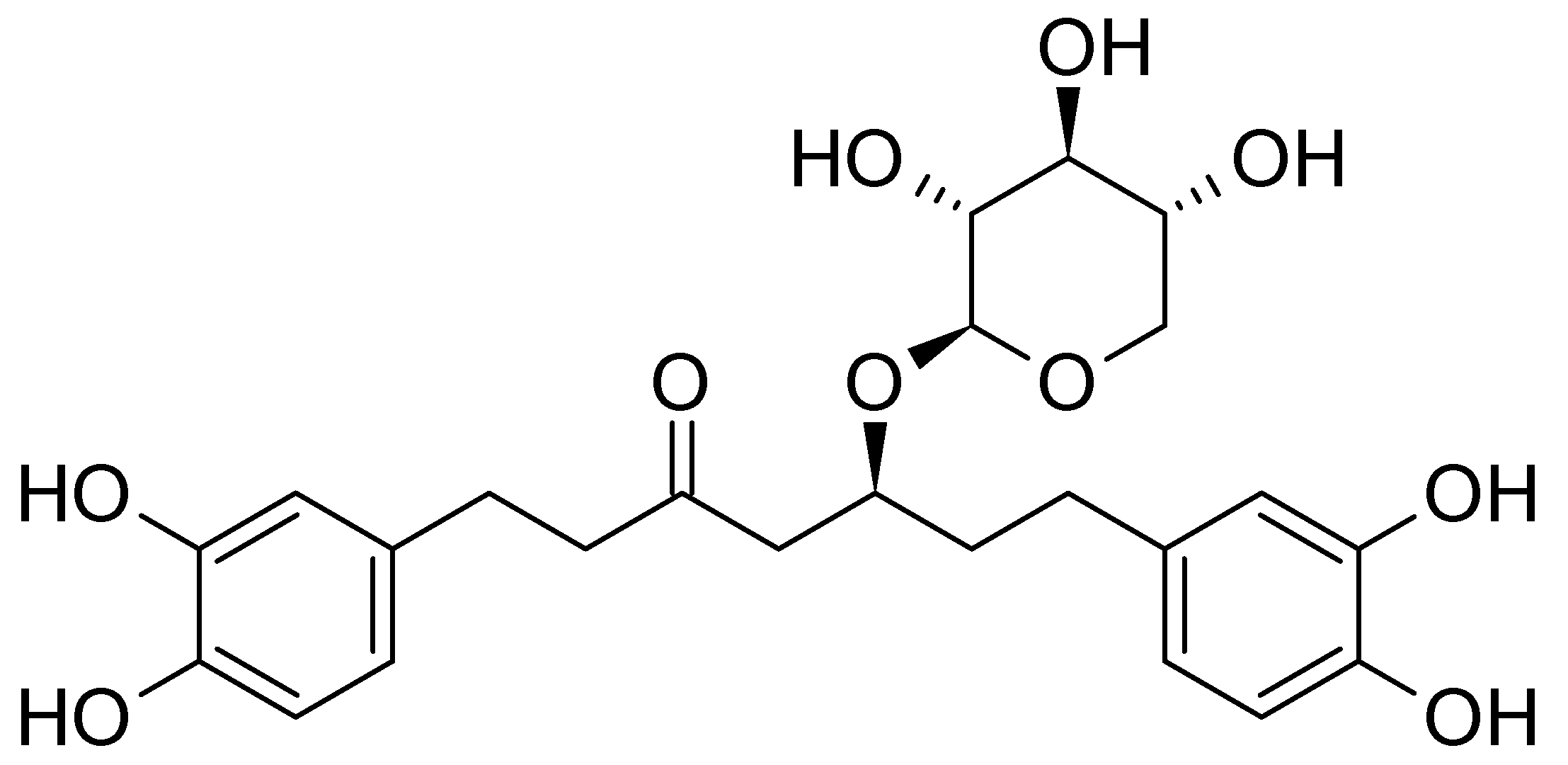
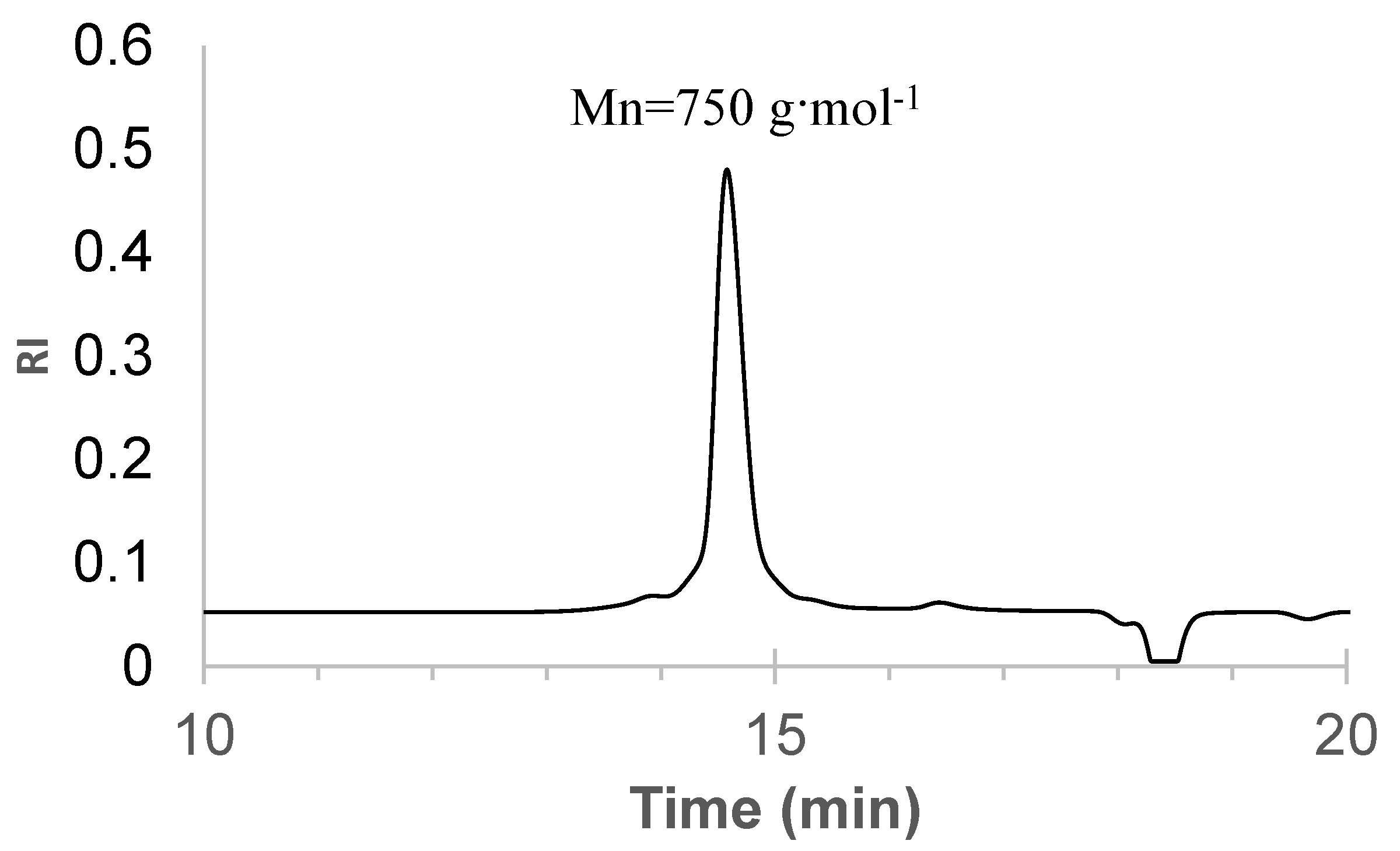
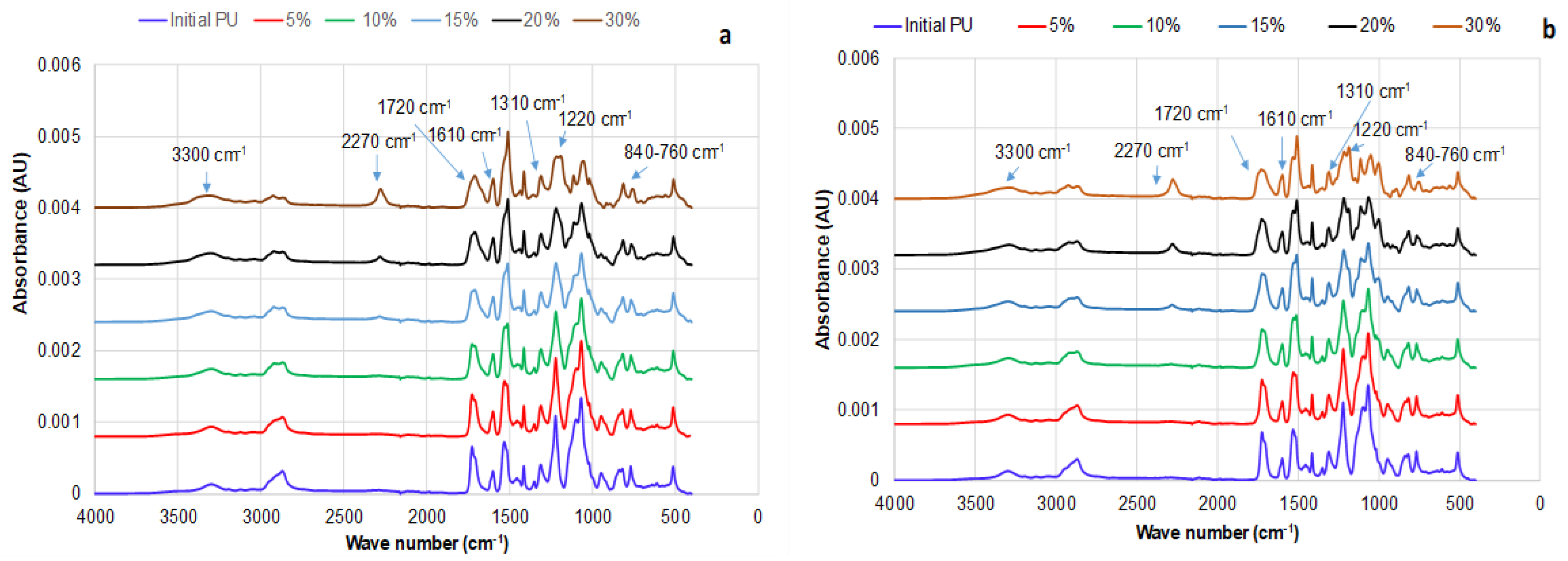

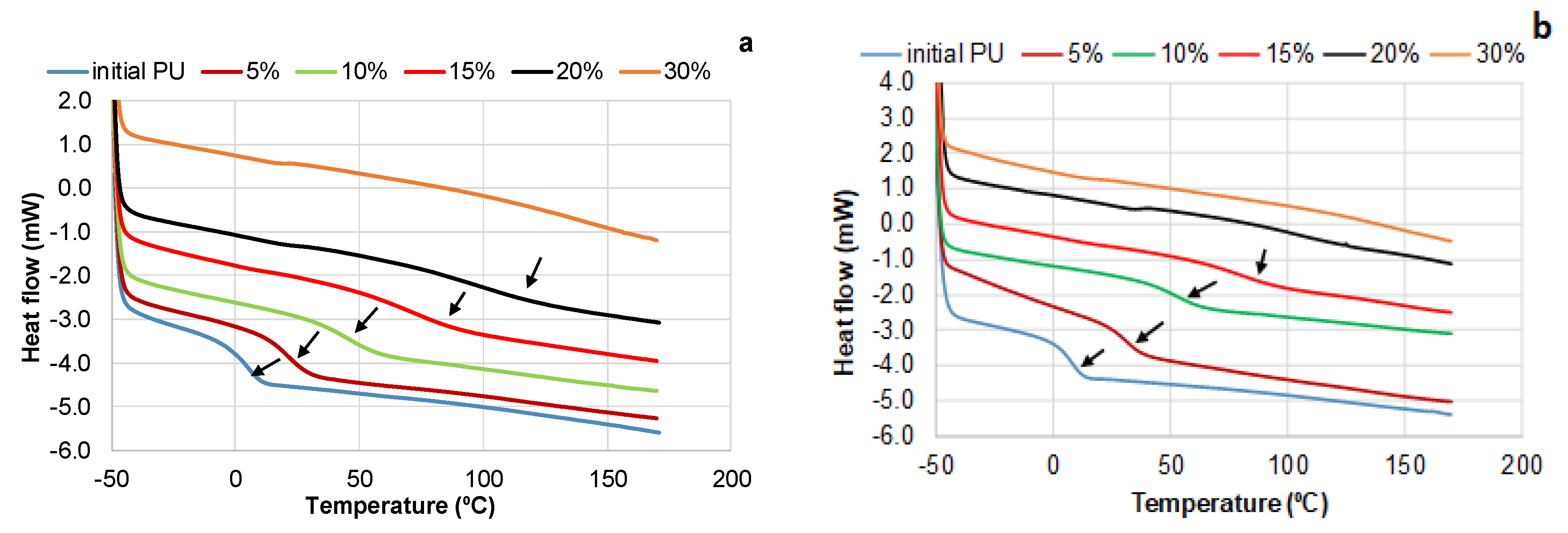
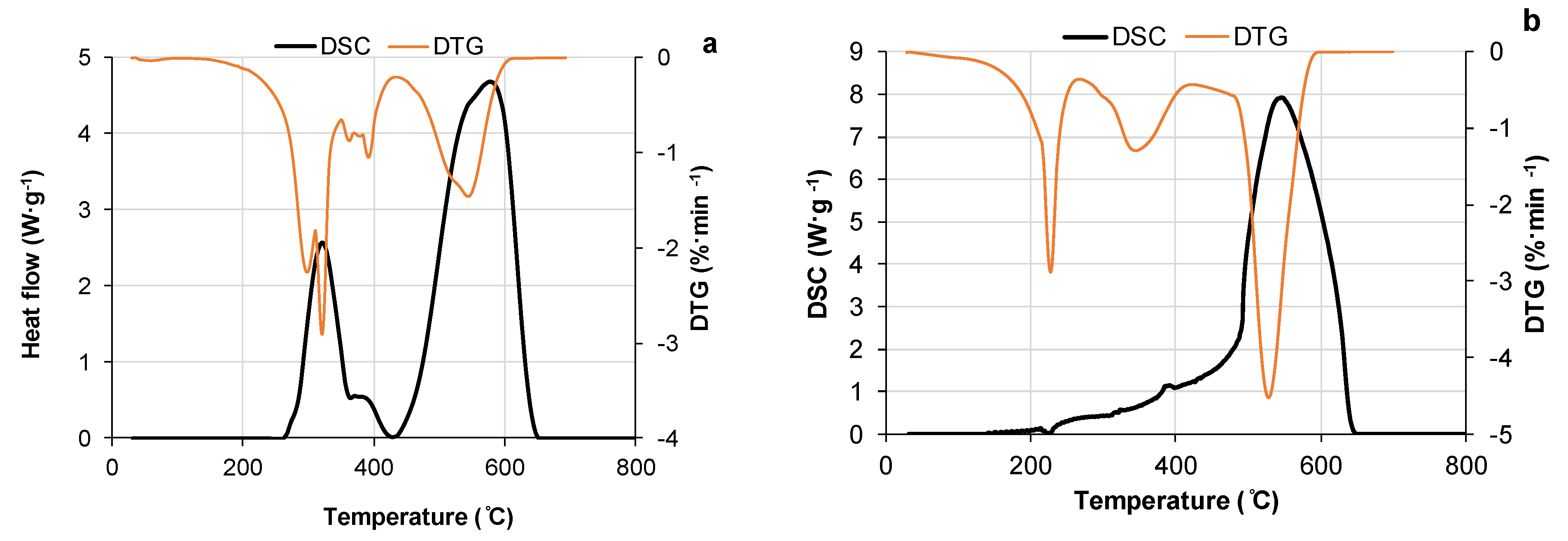
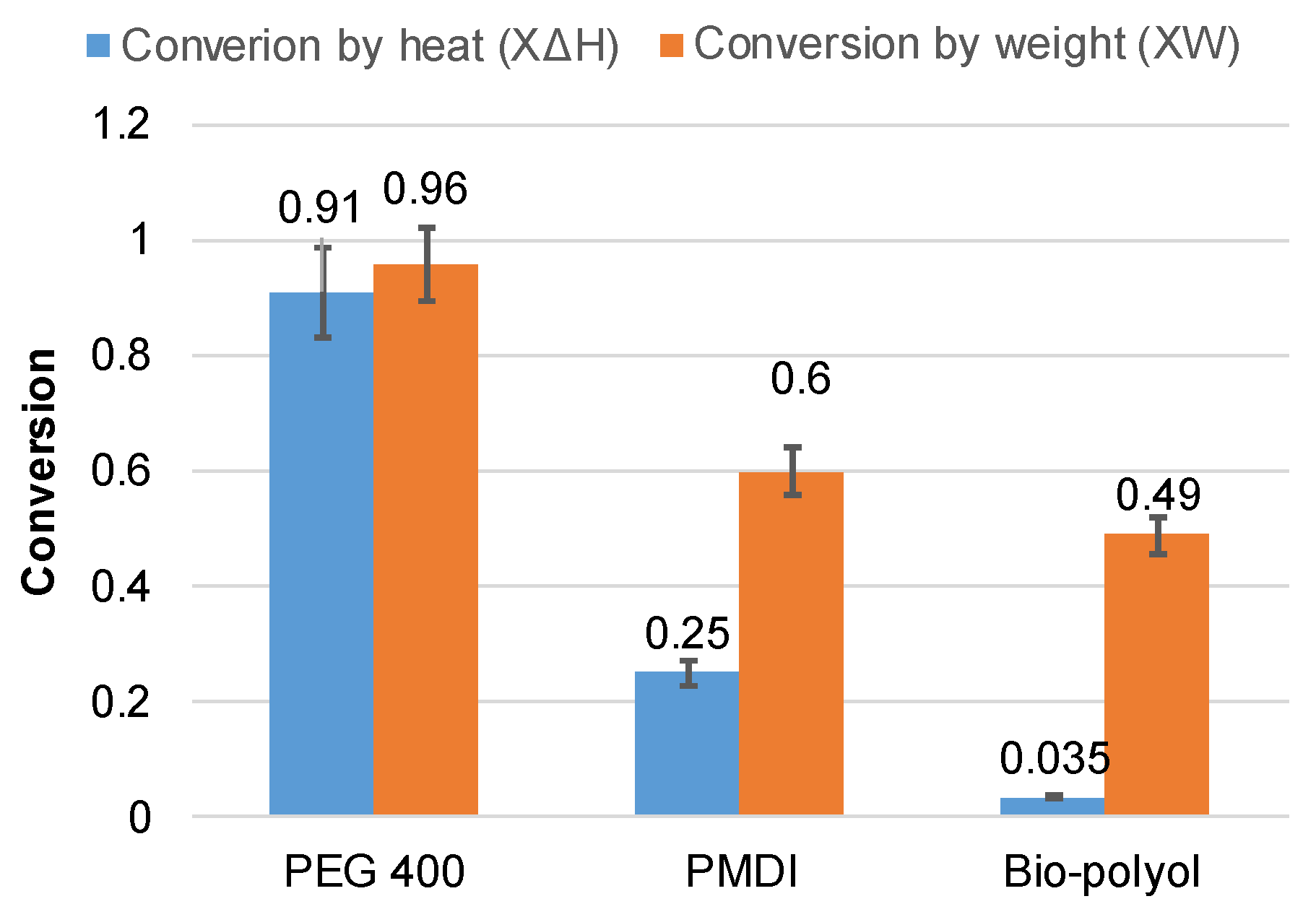
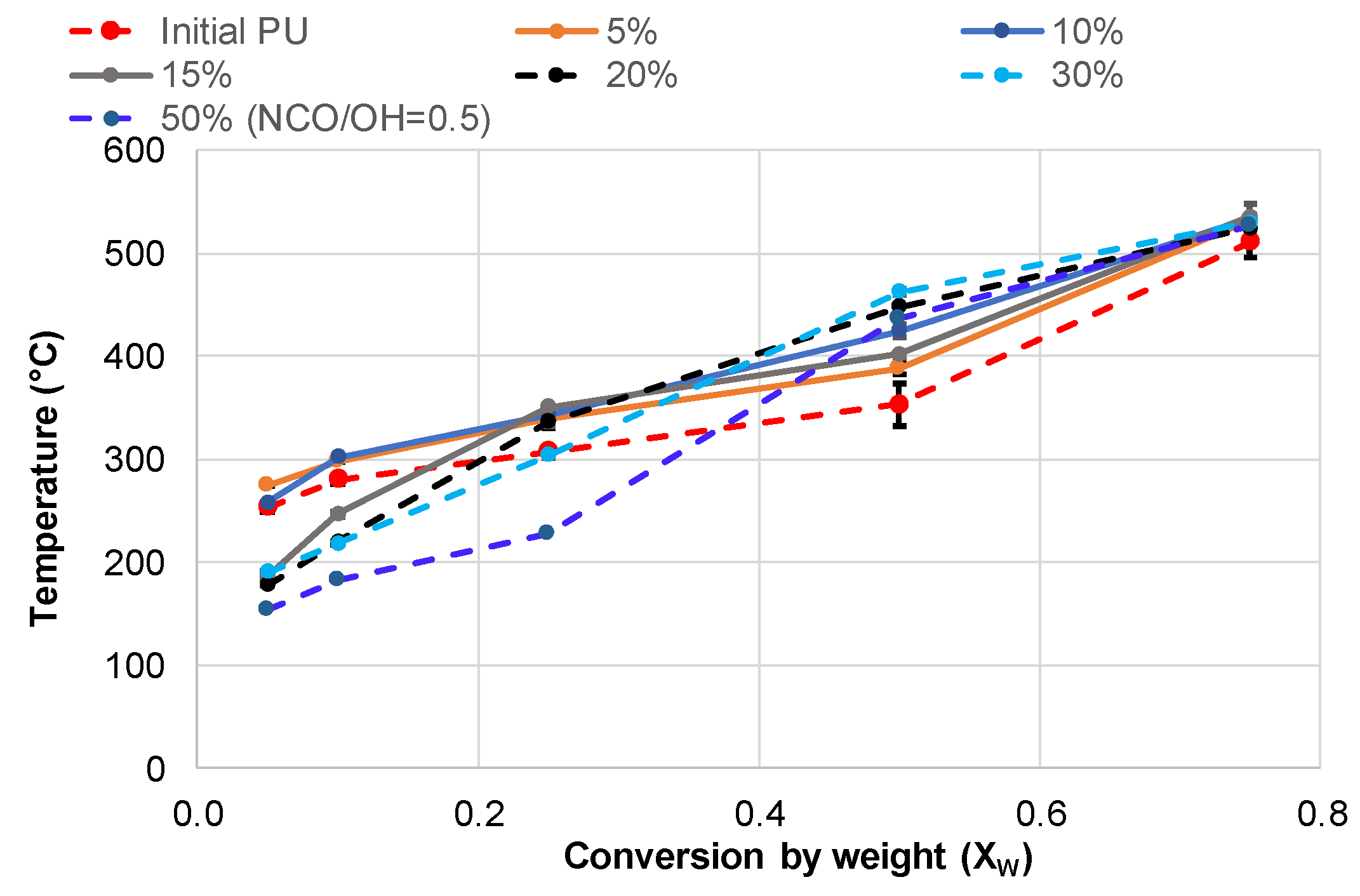


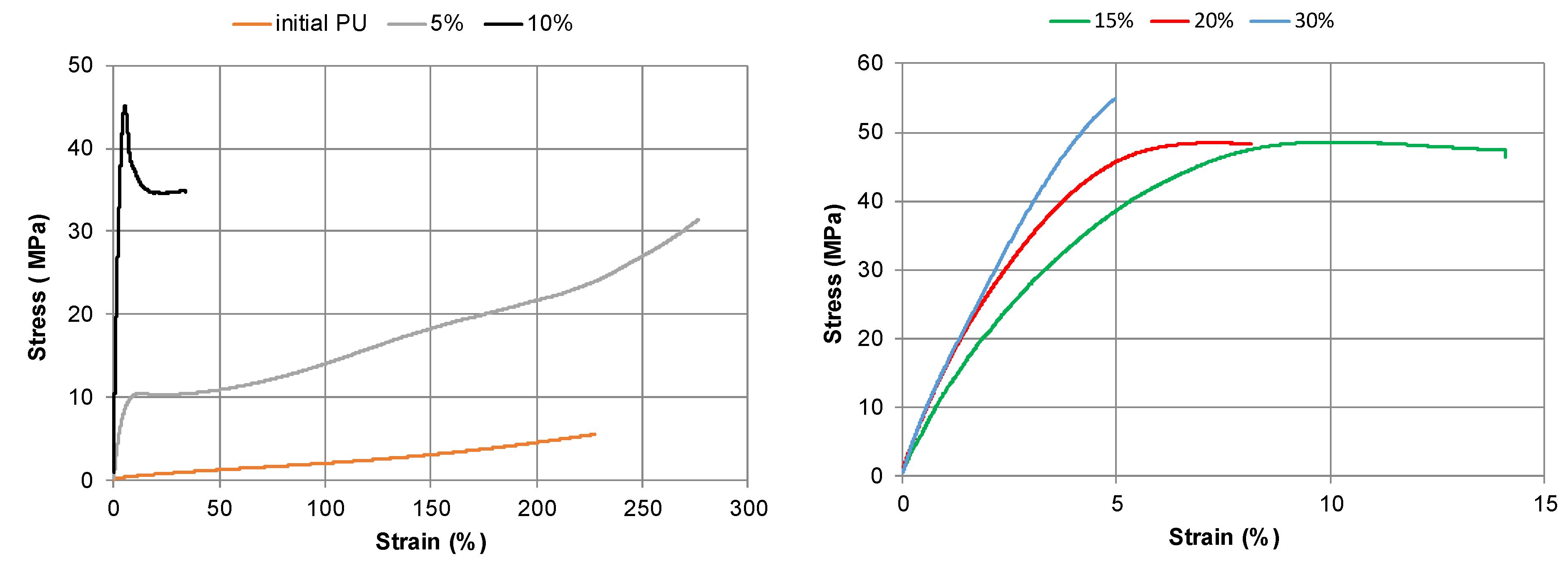

| T, min | A, % | B, % |
|---|---|---|
| 0 | 95 | 5 |
| 0.5 | 95 | 5 |
| 17 | 5 | 95 |
| 18 | 5 | 95 |
| 18.5 | 95 | 5 |
| 20 | 95 | 5 |
| Sample | Glc 1 | Gal 2 | Man 3 | Xyl 4 | Ara 5 | Rha 6 | Sum |
|---|---|---|---|---|---|---|---|
| Raw extract | 15.8 ± 0.7 | 1.5 ± 0.1 | 3.7 ± 0.2 | 15.1 ± 0.6 | 2.0 ± 0.4 | 0.12 ± 0.3 | 38.1± 2.3 |
| THF-soluble fraction | 10.5 ± 0.6 | n.d | 1.3 ± 0.2 | 23.0 ± 0.7 | 0.32 ± 0.10 | n.d | 35.1± 1.6 |
| THF-insoluble fraction | 23.7 ± 1.6 | 3.0 ± 0.3 | 7.5 ± 0.6 | 6.5 ± 0.3 | 3.9 ± 0.1 | 0.3 ± 0.1 | 44.9 ± 3.0 |
| Functional Group | Content (mmol·g−1) Wet Chemistry 31P NMR | |
|---|---|---|
| Aliphatic OH | 6.8 ± 0.7 | 8.4 |
| C5 substituted OH | - | 0.1 |
| Catechol OH | - | 8.2 |
| P-hydroxyphenyl OH | - | 0.4 |
| Total phenolic | 7.7 ± 0.5 | 8.7 |
| Carboxylic OH | 0.58 ± 0.05 | 0.2 |
| Total OH groups (∑OH) | 15.1 ± 1.3 | 17.2 |
| OH aliph/∑OH | 0.45 | 0.49 |
| Sample | Content in PU (%) Bio-Polyol PEG 400 PMDI | Substitution of PEG 400 (%) | Crosslink Density XLD·10−4 (mol·g−1) Mc (Da) | |||
|---|---|---|---|---|---|---|
| 1 | 0 | 60 | 40 | 0 | 0.38 | 5230 |
| 2 | 5 | 51 | 44 | 15.0 | 0.73 | 2740 |
| 3 | 10 | 42 | 48 | 30.0 | 1.08 | 1850 |
| 4 | 15 | 33 | 52 | 45.0 | 1.43 | 1400 |
| 5 | 20 | 24 | 56 | 60.0 | 1.77 | 1120 |
| 6 | 30 | 6 | 64 | 90.0 | 2.47 | 810 |
| 7 | 50 | 0 | 50 | 100 | 1.69 | 1180 |
| Composition | Bio-Polyol Content in PU (%) | DBTDL Tg (°C) ΔCp (J·g−1·K−1) | DABCO Tg (°C) ΔCp (J·g−1·K−1) | ||
|---|---|---|---|---|---|
| 1 | Initial PU | 4.9 ± 0.5 | 0.50 ± 0.03 | 5.6 ± 0.5 | 0.60 ± 0.05 |
| 2 | 5 | 21.5 ± 1.5 | 0.58 ± 0.06 | 32.0 ± 2.0 | 0.45 ± 0.02 |
| 3 | 10 | 45.7 ± 0.8 | 0.42 ± 0.03 | 53.5 ± 3.0 | 0.30 ± 0.03 |
| 4 | 15 | 74.6 ± 2.2 | 0.32 ± 0.02 | 82.9 ± 2.3 | 0.25 ± 0.02 |
| 5 | 20 | 103.9 ± 6.2 | 0.16 ± 0.01 | n.d | n.d |
| 6 | 30 | n.d | n.d | n.d | n.d |
| 7 | 50 | 110.7 ± 4.8 | 0.20 ± 0.03 | n.d | n.d |
| DBTDL Catalysts | DABCO Catalyst | ||||||
|---|---|---|---|---|---|---|---|
| Sample | Bio-Polyol Content in PU (%) | Temperature Range (°C) | Tmax 1 (°C) | Average Rate (%·min−1) | Temperature Range (°C) | Tmax 1 (°C) | Average Rate (%·min−1) |
| 1 | Initial PU | 254–436 | 328 ± 8 | 1.8 ± 0.1 | 256–460 | 396 ± 7 | 1.8 ± 0.1 |
| 2 | 5.0 | 275–439 | 325 ± 4 | 1.6 ± 0.2 | 271–458 | 377 ± 8 | 1.40 ± 0.2 |
| 3 | 10.0 | 258–451 | 331 ± 5 | 1.2 ± 0.1 | 234–451 | 343± 4 | 1.2 ± 0.1 |
| 4 | 15.0 | 187–435 | 387 ± 2 | 1.0 ± 0.1 | 180–459 | 395 ± 5 | 0.84 ± 0.05 |
| 5 | 20.0 | 178–442 | 383 ± 5 | 0.90 ± 0.07 | 156–460 | 402 ± 6 | 0.87 ± 0.06 |
| 6 | 30.0 | 189–426 | 229 ± 5 | 0.79 ± 0.05 | 171–424 | 229 ± 5 | 0.76 ± 0.10 |
| 7 | 50.0 | 154–430 | 207 ± 2 | 0.74 ± 0.10 | 156–436 | 208 ± 3 | 0.82 ± 0.07 |
| Parameter | PEG 400 | PMDI | Bio-Polyols |
|---|---|---|---|
| Temperature range (°C) | 215–360 | 232–520 | 168–440 |
| Tmax 1 (°C) | 290 ± 5 | 268 ± 7 | 224 ± 8 |
| Average rate (%·min−1) | 3.2 ± 0.2 | 2.1 ± 0.1 | 0.80 ± 0.07 |
Disclaimer/Publisher’s Note: The statements, opinions and data contained in all publications are solely those of the individual author(s) and contributor(s) and not of MDPI and/or the editor(s). MDPI and/or the editor(s) disclaim responsibility for any injury to people or property resulting from any ideas, methods, instructions or products referred to in the content. |
© 2023 by the authors. Licensee MDPI, Basel, Switzerland. This article is an open access article distributed under the terms and conditions of the Creative Commons Attribution (CC BY) license (https://creativecommons.org/licenses/by/4.0/).
Share and Cite
Arshanitsa, A.; Ponomarenko, J.; Pals, M.; Jashina, L.; Lauberts, M. Impact of Bark-Sourced Building Blocks as Substitutes for Fossil-Derived Polyols on the Structural, Thermal, and Mechanical Properties of Polyurethane Networks. Polymers 2023, 15, 3503. https://doi.org/10.3390/polym15173503
Arshanitsa A, Ponomarenko J, Pals M, Jashina L, Lauberts M. Impact of Bark-Sourced Building Blocks as Substitutes for Fossil-Derived Polyols on the Structural, Thermal, and Mechanical Properties of Polyurethane Networks. Polymers. 2023; 15(17):3503. https://doi.org/10.3390/polym15173503
Chicago/Turabian StyleArshanitsa, Alexandr, Jevgenija Ponomarenko, Matiss Pals, Lilija Jashina, and Maris Lauberts. 2023. "Impact of Bark-Sourced Building Blocks as Substitutes for Fossil-Derived Polyols on the Structural, Thermal, and Mechanical Properties of Polyurethane Networks" Polymers 15, no. 17: 3503. https://doi.org/10.3390/polym15173503
APA StyleArshanitsa, A., Ponomarenko, J., Pals, M., Jashina, L., & Lauberts, M. (2023). Impact of Bark-Sourced Building Blocks as Substitutes for Fossil-Derived Polyols on the Structural, Thermal, and Mechanical Properties of Polyurethane Networks. Polymers, 15(17), 3503. https://doi.org/10.3390/polym15173503








